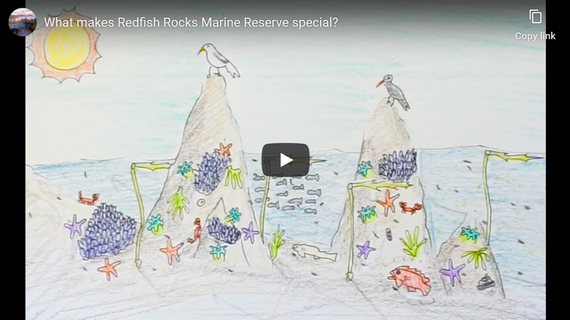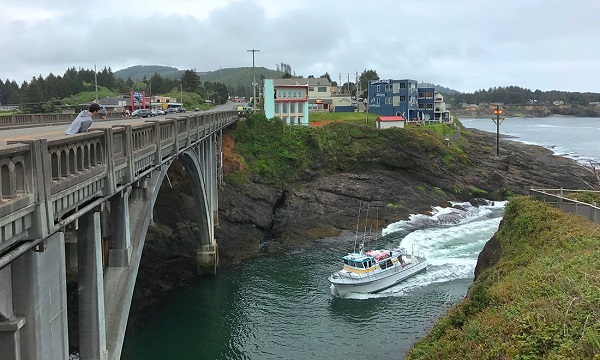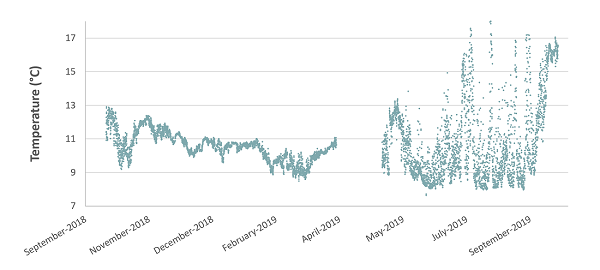Returning to the Reserves:
Tom Calvanese and Redfish Rocks
“When I see those emerging rocks, my mind immediately goes to what’s down there. It takes me to experiences of working as an urchin diver,” says Tom Calvanese of the role that offered him his first encounter with the area that is now the Redfish Rocks Marine Reserve.
Tom becomes visibly emotional as he reflects on the job and claims that it may have been his favorite job to date. The face mask he is donning muffles a chuckle when he later admits that he was likely the least efficient and most distracted urchin diver on the team. Tom’s immersive first contact with the area had a lasting impact.
“I’ll say for sure, in retrospect, that the experiences from those dives were way more valuable than the money that I made,” he says of the dividends that would pay off in later roles within the same waters.

Tom had been using his job as an urchin diver to help fund his graduate education in fisheries science at Oregon State University (OSU). His studies are what attracted Tom to Port Orford in the first place. Responding to concerns of the local fishing community, Tom developed his Fishtracker study to monitor the movement patterns of six rockfish species and the potential for the impending marine reserve to protect them. His engagement with the fishing community also, quite literally, floated the project.
“It was a true collaboration,” Tom says of the study that relied on trips with fishermen to capture and implant rockfish with acoustic telemetry tags.
A relic from Tom’s student experience welcomes visitors to the OSU Port Orford Field Station that he now manages. A sign that reads “I do my research with Port Orford Fishermen” hangs in the window of his office at the field station’s entrance.
|

“This field station really is here as the result of some really engaged local people who wanted to see the research happen in association with the marine reserve,” he says, “and it was actually local commercial fishermen who organized to propose the reserve, and as part of that proposal, they were pretty clear in their expectation that it would be studied.”
Beyond the expectations from the community to use Redfish Rocks as a living laboratory, Tom’s explanation of the field station’s capacity to provide that experience mirrors his own history with the place.
Join us as we talk further with this urchin diver -- turned fisheries scientist -- turned field station manager as we explore his connections with this special place.
|

A Video Short by OSU-MSI Intern:
“What Makes the Redfish Rocks Marine Reserve Special?”

Check out this video created by OSU-Marine Studies Initiative Intern, Tom McCambridge. Tom spent his summer internship at the OSU Port Orford Field Station, which has an expansive view of the Redfish Rocks Marine Reserve, located in the small fishing town of Port Orford on Oregon’s south coast. Tom combined drone and underwater video footage with his drawing and art skills to create this 4 minute video, showing us what makes the Redfish Rocks Marine Reserve special.
About OSU-Marine Studies Initiative Intern Tom McCambridge
Tom is an incoming senior studying marine biology and chemistry at Oregon State University (OSU). He originally hails from San Jose, California. He’s excited to get a better understanding of the effects that conservation efforts can have on communities that depend on natural resources. His hope is that this will allow him to find a balance between benefiting the environment and ensuring the wellbeing of people as marine conservation becomes more urgent.

New Report: Qualitative Evaluation of Impacts on Commercial & Charter Fishers

This project is designed to capture the lived experience of commercial and charter fishers who are directly impacted by marine reserves. We were particularly interested in the economic, social, and cultural impacts of the marine reserves, including whether or not fishers were shifting their efforts to other species or locations following reserve implementation. This project sought to hear from fishers about their own experiences and perspectives.
Big Picture Takeaways
- Marine reserves are not divorced from other resource management decisions in the minds of fishers and other coastal residents. Therefore, while fishers often know more about marine reserves than the Oregon public at large, perspectives on the reserves are often tied to perspectives on other management and conservation projects and strategies.
- Given the challenges of the fishing industry, and changes or loss in fishing opportunity over the years, this conflation means that fishers often have negative reactions to marine reserves despite most fishers - though not all - saying that the current five reserves have had a nominal economic impact.
- Communication strategies and cultural worldviews differ among fishers and non-fishers along the coast. These different worldviews and communication strategies may exacerbate conflict among different constituencies.
- There was genuine interest from many of the fishers to work with scientists and managers to get a better understanding of the ocean. Fishers expressed frustration that their knowledge is often referred to as anecdotal rather than seen and valued as expert knowledge.
- Positive experiences with marine reserves could have ripple effects on establishing better manager/fisher/scientist interactions. In turn, improving this dynamic has the potential to increase community resilience to risk by improving trust and efficiency in decision-making.
This project was led by Dr. Elizabeth Marino, an Associate Professor of Anthropology and Sustainability at Oregon State University - Cascades, in collaboration with the ODFW Marine Reserves Program. This research is part of on-going qualitative investigations into the impacts and experiences of the fishing community along the coast of Oregon in response to marine reserve implementation.
  
A Dip Into Oceanographic Data
August has been a month focused on oceanography. We currently have oceanographic moorings in the water at Cascade Head, Cape Falcon, and the Cape Meares Comparison Area collecting data on temperature, salinity and oxygen. We’ve also been diligently working up the first oceanographic data collected at Cape Falcon from last year. The results have been very interesting so far.

Above is a time series of temperature data collected at 15m depth, spanning September 2018-September 2019 at Cape Falcon. Over the winter, temperatures were fairly consistent, with gradual increases and decreases in temperature. But during the summer months, we see large and rapid changes in temperature. This is largely the result of wind-driven upwelling and downwelling events that occur from late spring to early fall, and show the stark contrast in temperature shifts between winter and summer seasons.
Stay tuned for more oceanographic data from the additional four marine reserve sites.
Explore More Marine Reserves News

|













